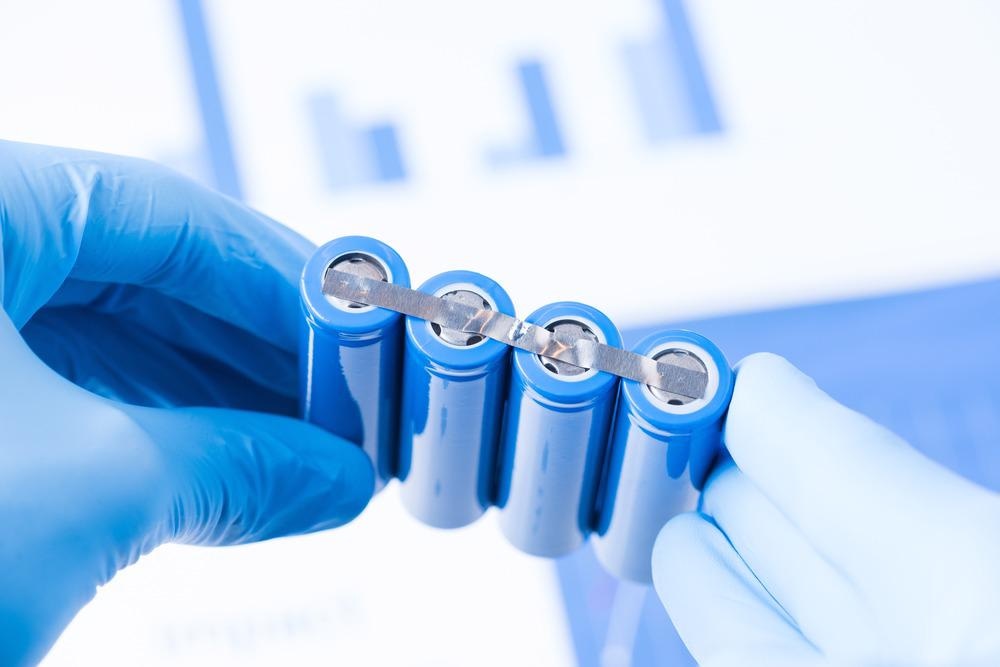 By Surbhi JainReviewed by Susha Cheriyedath, M.Sc.Feb 9 2022
By Surbhi JainReviewed by Susha Cheriyedath, M.Sc.Feb 9 2022In an article recently published in the Journal of Hazardous Materials, researchers reported the recycling process of precious metals from spent cathode materials through organic pyrolysis technique at low temperature. They also discussed the efficiency of organics, conductive additives, and aluminum foil towards the reduction of high-valence transition metals.

Study: Recycling of valuable metals from spent cathode material by organic pyrolysis combined with in-situ thermal reduction. Image Credit: nevodka/Shutterstock.com
Background
Spent lithium-ion batteries (LIBs), which are formed from commonly used LIBs with a short service life, contain a substantial number of important metals, which have a significant recovery value and can pollute the environment. In order to address the scarcity of crucial metal resources and meet environmental protection regulations, an increasing number of researchers are focusing on the effective recycling of LIBs. Physical pre-treatment approaches combined with metallurgical procedures have been researched in recent years as a way to recycle valuable materials from used LIBs.
The separation and purification of precious metals recovered from wasted LIBs rely heavily on metallurgical technologies, particularly hydrometallurgy, which can provide high-purity metal compounds. Some organic reductants have been utilized in the leaching process to minimize environmental pollution. The most prevalent form of reduction pre-treatment is carbon thermal reduction. Although carbon thermal reduction can speed up the leaching process, it also consumes more carbon resources, resulting in resource waste and pollution.
A novel approach that does not require any additional carbon materials and may be used in conjunction with other recycling procedures needs to be researched further.
Organic binders link conductive additives (carbon black), cathode materials, and aluminum foils together in used cathode scraps. To improve the liberation and flotation capability of electrode materials, thermal treatment was used to eliminate organics immersed in cathode material particles. Previous studies have shown that carbon black, organic binders, and aluminum foils could be used as a reducing agent in the heat-treatment process.
About the Study
In the present study, the removal of organics, the liberation of electrode material, and the reduction of high valence transition metal, all of which are important factors in the recycling efficiency of valuable metals, were achieved simultaneously using a low-temperature heat treatment recycling process. The thermal reduction mechanism, organic pyrolysis properties, and the phase transition behavior of wasted cathode material were also evaluated.
Surface micro-properties of wasted cathode electrode material were investigated using scanning electron microscopy (SEM), energy-dispersive X-ray spectroscopy (EDS), and X-ray photoelectron spectroscopy (XPS) to determine the effect of additives on the phase transition of spent cathode electrode material. Thermal gravimetric analyzers, thermogravimetry (TG), and derivative thermogravimetry (DTG) were used to assess the thermal weight-loss behavior of organics in the wasted cathode material.
X-ray diffraction (XRD) was used to investigate the phase transition behavior of used cathode scraps. A metal recycling flowchart obtained from discarded cathode materials was presented. High-valence transition metals in the cathode material were reduced via phase analysis without the usage of reducing agents. The acid-leaching without reduction was used to recycle Ni, Co, and Mn from heat-treated cathode material directly.
Observations
In this study, the researchers observed that the pyrolysis technique eliminated organics and increased the liberation of electrode materials. It was also found that the reducing action of organics, aluminum foil, and conductive additives led to the reduction of high-valence transition metals in cathode materials to CoO, NiO, MnO, Ni, and Co.
The team observed that the reducing action of carbon black, organic binder, and aluminum foils helped achieve the in situ thermal reduction of cathode material by modifying the pyrolysis settings. Lithium (a water-soluble chemical) was extracted after the thermal reduction procedure.
More from AZoM: Differential Thermal Analysis of Technical Ceramics
The lithium-selective leaching reduced the complexity of successive metal separation and purification. Pyrolysis products, conductive additives, and aluminum foils reduced the high-valence transition metals in cathode materials to low-valence oxides and elemental compounds. The release of electrode materials and current collector was achieved using a water crushing technique. Li element was found to dissolve as well as recycle in water via evaporative crystallization.
The water-leaching procedure recovered 81.26% of lithium, while the acid-leaching technique recycled the remaining lithium completely. After thermal reduction, Ni, Co, and Mn were recycled by acid leaching without the use of reducing agents. Ni, Co, and Mn had comprehensive recovery rates of 92.04%, 93.01%, and 92.21%, respectively.
Conclusions
In conclusion, this study elucidates the potential of organic pyrolysis in combination with the in situ thermal reduction of cathode material towards the recycling of precious metals from used ternary LIBs. Advanced analysis technologies disclose the in situ reduction methodology of high-valence metals in used electrode materials. A new flowchart for recycling precious metals from wasted LIBs is proposed. The study also sheds light on the solubility of Al in Li salt solutions as well as in Ni, Co, and Mn solutions.
The authors believe that the removal of the Al element is a required step that should be investigated further. Also, this study emphasizes the importance of fine-tuning the thermal treatment parameters to maximize the recovery efficiency of precious metals.
Disclaimer: The views expressed here are those of the author expressed in their private capacity and do not necessarily represent the views of AZoM.com Limited T/A AZoNetwork the owner and operator of this website. This disclaimer forms part of the Terms and conditions of use of this website.
Source:
Zhang, G., Liu, Z., Yuan, X. et al. Recycling of valuable metals from spent cathode material by organic pyrolysis combined with in-situ thermal reduction. Journal of Hazardous Materials 128374 (2022). https://www.sciencedirect.com/science/article/abs/pii/S0304389422001625